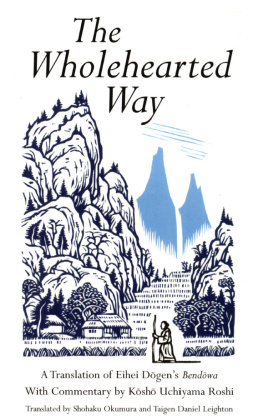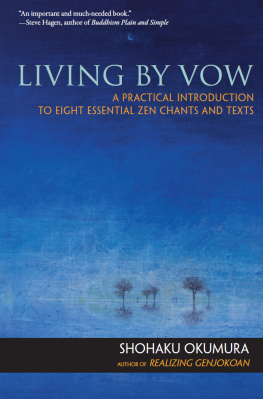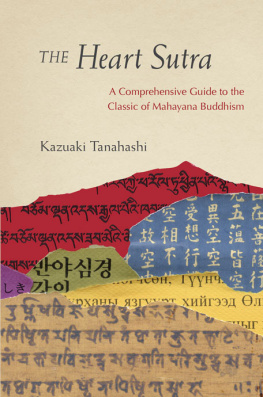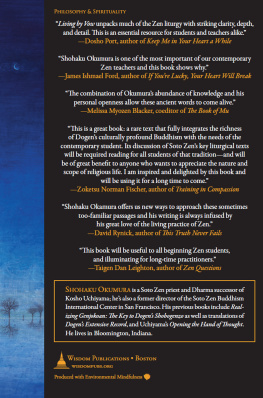ABOUT THE BOOK
A Zen chant is like a compass that sets us in the direction of the awakened life; it is the dynamic, audible counterpart to the silent practice of zazen, or sitting meditation; and it is a powerful expression of the fact that practice happens in community. Here is a concise guide to Zen chants for practitioners, as well as for anyone who appreciates the beauty and profundity of the poetry in dharma. An introduction to the practice is followed by fresh and carefully considered translations and adaptations of thirty-five chantssome common and others less well knownalong with illuminating commentary.
KAZUAKI TANAHASHI, a Japanese-trained calligrapher, is the pioneer of the genre of one stroke painting as well as the creator of multicolor enso (Zen circles). His brushwork has been shown in solo exhibitions in galleries, museums, and universities all over the world. Tanahashi has edited several books of Dogens writings and is also the author of Brush Mind.
Sign up to receive weekly Zen teachings and special offers from Shambhala Publications.

Or visit us online to sign up at shambhala.com/ezenquotes.
Zen Chants
Thirty-Five Essential Texts with Commentary
Kazuaki Tanahashi
PHOTOGRAPHY BY MITSUE NAGASE

S HAMBHALA
BOSTON & LONDON
2015
Shambhala Publications, Inc.
Horticultural Hall
300 Massachusetts Avenue
Boston, MA 02115
www.shambhala.com
Cover art by Cheryl Cahn
Cover design by Liza Matthews
Author photo by Joshi Radin
2015 by Kazuaki Tanahashi
Photographs 2015 by Mitsue Nagase
All chants in parts one and two are in the public domain.
All rights reserved. No part of this book may be reproduced in any form or by any means, electronic or mechanical, including photocopying, recording, or by any information storage and retrieval system, without permission in writing from the publisher.
Library of Congress Cataloging-in-Publication Data
Tanahashi, Kazuaki, 1933 author.
Zen chants: thirty-five essential texts with commentary / Kazuaki Tanahashi; photography by Mitsue Nagase.
First edition.
pages cm
Includes bibliographical references.
eISBN 978-0-8348-0043-4
ISBN 978-1-61180-143-9 (pbk.: alk. paper)
1. Zen BuddhismPrayers and devotions. I. Nagase, Mitsue. II. Title.
BQ9287.4.t36 2015
294.3438dc23
2014033961
To Sojun Mel Weitsman
with smiles and bows
C ONTENTS
PUBLISHERS NOTE
This book contains some diacritics and special characters. If you encounter difficulty displaying these characters, please set your e-reader device to publisher defaults (if available) or to an alternate font.
T HE RECITATION OF CHANTS both during a meditation gathering and outside of itrepresents the aspiration, vows, realization, and commitments of Zen practitioners. Some chants are recited daily, while others are used only for special occasions. The recitation process helps to shape, confirm, and expand your meditation experience and mindfulness practice. Thus, by familiarizing yourself with Zen chants, you access the spirit of Zen and gain insight.
The landscape of Zen practice fills monasteries, Buddhist centers, and Zen gatherings. Beyond such settings, meditation can be conducted almost anywhereat home, in a hospital, in nature, on an airplane or boat, or in a train station. In reality, it can be done anywhere on the globe. Mitsue Nagases photography in this book suggests diverse settings for meditation and chantingin sitting postures, walking meditation, ceremonies, services, as well as during mindful working, eating, and other meditation-based daily activitiesin a variety of places in the United States, Europe, and Asia.
It is my great pleasure to present a selection of translations recited in English-speaking countries. In these regions, Chan or Zen groups, whose traditions originate in China, Korea, Japan, and Vietnam, commonly recite some of these chants in a variety of translations. Some of the verses were recited originally in Sanskrit, and many in Chinese. Other texts derive from Japan and are recited only by groups of Japanese origin, such as the Soto and Rinzai schools.
I have arranged the materials as a text that is interesting for reading, instead of in the usual chanting order. Chants in this book are divided into four parts: Daily Chants, Chants for Events, Enlightenment Poems, and Chants for Study. However, this classification is rather arbitrary. In monasteries and Zen centers, some of the chants classified otherwise may be chanted daily. In small groups, those that are classified here as daily chants may be chanted only during special events.
Many of the Zen groups I am associated with have been established by teachers from Japan, so they chant some versions in Japanese. That explains my choice of texts and transliterations in Japanese. Regrettably, I have been unable to find female teachers enlightenment poems for chanting or study. Thus, the texts I present in this book were all written by male teachers. Some American groups have begun chanting the names of female buddha ancestors; I am including one such chant here, hoping to address the imbalance in gender in our heritage.
Zen has a history of about fifteen hundred years, but some of the Buddhist chants presented here emerged over two thousand years ago. The newest chant I am including, other than the names of female buddha ancestors, is from the eighteenth century. Numberless Zen practitioners have engaged in the process of finding, selecting, and maintaining the originals of what we chant now. This book responds to a need for a collection/book of chants that is easy to understand, fluid for chanting, and relevant to contemporary Western values.
For over thirty years, I have been translating Zen chants with outstanding collaborators. These translations are inspired by a great variety of recitations I participated in while visiting dharma centers of different traditions in North America and Europe, where I teach East Asian calligraphy and at times give dharma talks.
I fully understand if you prefer to stay with the versions you have been chanting for years. Still, I encourage you and your group to use this book as a referenceboth to reexamine chants you know and love, and to create new versions of the chants. You may also enjoy learning about the history of the chants outlined in the Texts Illuminated part of this book.
As most of the texts included in this book are derived from China, I present the Chinese ideographic versions of them in the Texts Illuminated part. You may not be familiar with ideographs, and they may have no meaning for you. However, just in case you are curious about original expressions, they are there. In the introduction, I will explain how to find online the meanings, pronunciations, and etymology of an ideograph. With this method, and without knowledge of an East Asian language, any of you can explore the world of ideography with great ease.
Because I designed this volume to serve as your final source book, so that you wont have to look for other books for your study, I am using macrons indicating long vowels in the main text. But the distinction between long and short vowels does not matter so much in English; macrons can be omitted for further use.
My first gratitude goes to countless practitioners of Chan and Zen all over East Asia, who have kept chanting these verses over a millennium and a half. The stunning insights of ancient Chinese and Japanese masters are still inspiring. The scholarship of commentators on these texts helps us to clarify their meanings.
Next page














